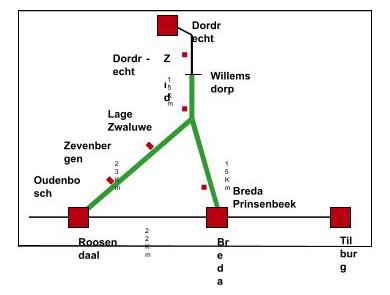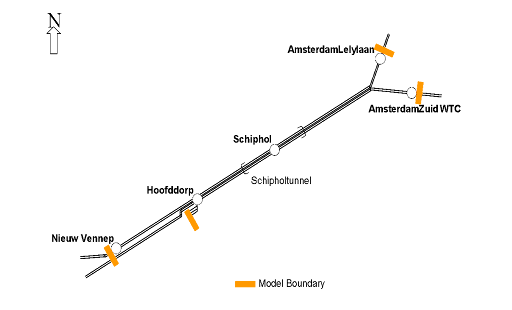TMS History
1995-2000
On AIR begins to study the railway traffic optimization problems with the EU projects MARCO.
2000-2003
The TMS was developed under two subsequent EU projects, named COMBINE and COMBINE 2, and it was enhanced during application studies by ProRail (NL)
2004
The green wave
The pilot "The Green Wave", actually called "de Groene Golf" (dGG) was carried out in June 2004 and was a first attempt to test TMS in practice.

The bottleneck in the pilot area is the junction at Lage Zwaluwe. Trains that, due to delays, are required to stop at this bottleneck, generally see their delay becoming ever longer, as a result of the waiting time and the running time lost because of the slowing down and subsequent re-acceleration of the train. The consequences are disadvantageous for all trains, but they are far-reaching for heavy goods trains, whose time losses can amount to as much as 10 minutes. These unplanned stops can result in delays also for the following trains.
2005
Starting from 2005, TMS connects with Flexible Rail Infra Simulation of Operations (FRISO) in simulation environments.
2007
The Schiphol bottleneck
A study was carried out to verify if the use of a TMS could be effective to manage the forecasted increased traffic at Schiphol bottleneck in 2007. The study addressed the problem of efficiently using the capacity of the existing railway network and improving reliability and punctuality of train operations. The study verified the effectiveness of the TMS global approach by means of simulations on different traffic scenarios.
The research area comprises all tracks between Nieuw Vennep on the east side, Amsterdam Lelylaan on the north side and Amsterdam Zuid WTC on the south side. At the Hoofddorp location a number of storage sidings operate as origin or destination for trains.

2009
‘s-Hertogenbosch
A simulation study has been executed for an area of reasonable size and complexity, where an actual control challenge currently exists. TMS results have been compared statistically to a number of other strategies (FCFS, VaVo: FCFS with maintaining timetable order for trains having the same end-track in a route).
2013
Speed control study for ETMET project ("Each Ten Minutes a Train")
The ETMET project studied the possibility to grant a frequency of one passenger train every 10 minutes, on a mainly two-track route where will run six intercity trains, six regional trains and two freight trains (total 14 trains) per hour in the morning and evening peak hours.
2013
Rail Copenhagen 2013
Presented at the Rail Copenhagen event in 2013, Prorail perfomed a case study in the Den Bosh area, with higher train frequencies. The study compared results of FRISO running standalone using FCFS and "current practice" (VaVo) route setting policy with TMS route setting based on global optimization.
2015
ERTMS Level 2 (+ dual signalling areas)
The European Railway Traffic Management System (ERTMS) is a major industrial project designed to enhance cross-border interoperability through Europe by creating a single standard for railway signalling. There are three different levels of ERTMS/ETCS application, L-1, L-2 and L-3, based on the need for existing railway infrastructure. L-2 does not require line-side signals. The movement authority communication occurs directly from a Radio Block Centre (RBC) to the on-board unit.
2019 - Today
Automatic Train Operation (ATO)
A deep TMS rework to be compliant with the upcoming ATO standard. The Speed Regulation module has been removed and TMS is limited to the trackside and generates new plans, while ATO is implemented onboard of trains and uses the supplied plan to calculate an optimum speed profile.
Despite the loss of control capabilities over the network the entire global optimization method has been redesigned to achieve the fastest computational performance. The new TMS-ATO can calculate an optimal plan for more than 70 running trains in less than 2 seconds.


